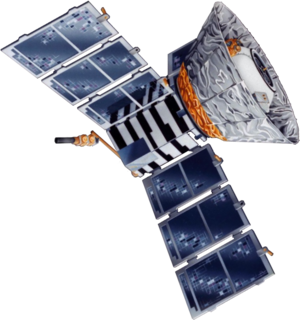
Back مستكشف الخلفية الكونية Arabic কসমিক ব্যাকগ্রাউন্ড এক্সপ্লোরার Bengali/Bangla Cosmic Background Explorer BS COBE Catalan پشکنەری بەکگراوندی گەردوون CKB COBE Czech Cosmic Background Explorer German COBE Spanish کاوشگر زمینه کیهان Persian COBE Finnish
 Artist's concept of the COBE spacecraft | |
| Names | Explorer 66 |
|---|---|
| Mission type | Cosmic microwave background Astronomy |
| Operator | NASA |
| COSPAR ID | 1989-089A |
| SATCAT no. | 20322 |
| Website | lambda.gsfc.nasa.gov/product/cobe |
| Mission duration | 6 months (planned) 4 years, 1 month and 4 days (achieved) |
| Spacecraft properties | |
| Spacecraft | Explorer LXVI |
| Spacecraft type | Cosmic Background Explorer |
| Bus | COBE |
| Manufacturer | Goddard Space Flight Center |
| Launch mass | 2,206 kg (4,863 lb) [1] |
| Dry mass | 1,408 kg (3,104 lb) [2] |
| Dimensions | 5.49 × 2.44 m (18.0 × 8.0 ft) |
| Power | 750 watts |
| Start of mission | |
| Launch date | 18 November 1989, 14:34 UTC |
| Rocket | Delta 5920-8 (Delta 189) |
| Launch site | Vandenberg, SLC-2W |
| Contractor | Douglas Aircraft Company |
| Entered service | 18 November 1989 |
| End of mission | |
| Deactivated | 23 December 1993 |
| Orbital parameters | |
| Reference system | Geocentric orbit[3] |
| Regime | Sun-synchronous orbit |
| Perigee altitude | 900 km (560 mi) |
| Apogee altitude | 900 km (560 mi) |
| Inclination | 99.00° |
| Period | 103.00 minutes |
| Instruments | |
| Differential Microwave Radiometer (DMR) Diffuse Infrared Background Experiment (DIRBE) Far-InfraRed Absolute Spectrophotometer (FIRAS) | |
 Cosmic Background Explorer mission patch Explorer program | |
The Cosmic Background Explorer (COBE /ˈkoʊbi/ KOH-bee), also referred to as Explorer 66, was a NASA satellite dedicated to cosmology, which operated from 1989 to 1993. Its goals were to investigate the cosmic microwave background radiation (CMB or CMBR) of the universe and provide measurements that would help shape our understanding of the cosmos.
COBE's measurements provided two key pieces of evidence that supported the Big Bang theory of the universe: that the CMB has a near-perfect black-body spectrum, and that it has very faint anisotropies. Two of COBE's principal investigators, George F. Smoot and John C. Mather, received the Nobel Prize in Physics in 2006 for their work on the project. According to the Nobel Prize committee, "the COBE project can also be regarded as the starting point for cosmology as a precision science".[4]
COBE was the second cosmic microwave background satellite, following RELIKT-1, and was followed by two more advanced spacecraft: the Wilkinson Microwave Anisotropy Probe (WMAP) operated from 2001 to 2010 and the Planck spacecraft from 2009 to 2013.
- ^ "COBE Mission Design, Spacecraft and Orbit". Goddard Space Flight Center. 18 April 2008. Retrieved 21 July 2015.
- ^ Crouse, Megan (16 July 2015). "Cosmic Background Explorer". Product Design & Development. Retrieved 21 July 2015.[permanent dead link]
- ^ "Trajectory: COBE (1989-089A)". NASA. 28 October 2021. Retrieved 27 November 2021.
 This article incorporates text from this source, which is in the public domain.
This article incorporates text from this source, which is in the public domain.
- ^ "The Nobel Prize in Physics 2006". The Royal Swedish Academy of Sciences. 3 October 2006. Retrieved 23 August 2011.
© MMXXIII Rich X Search. We shall prevail. All rights reserved. Rich X Search